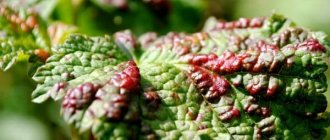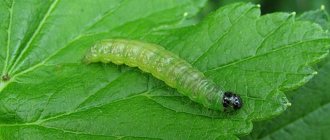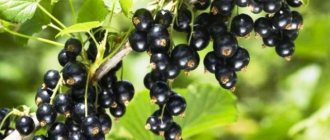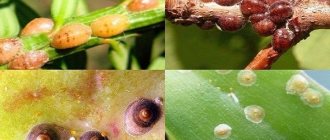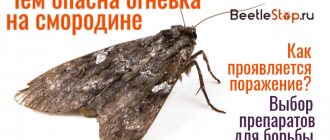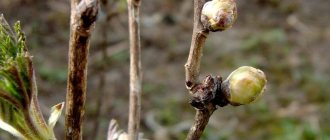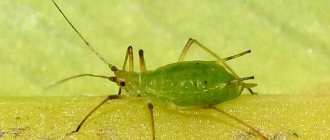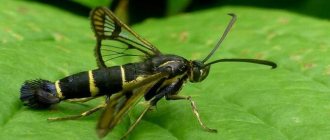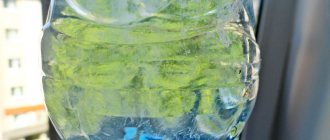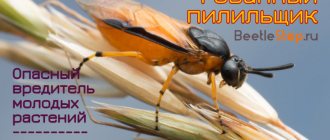The scale insect is a small, up to 5 mm, armored insect that feeds on the juices of currant leaves, ovaries and branches. The insect spreads very quickly and affects not only currant bushes, but also gooseberries, raspberries, cherries, and cherries.
The first signs are small yellow spots, which grow over time until the leaves fall from the bush. If you notice it in the early stages (yellow spot), then the bush can still be saved, but if there is a large fall of curled leaves, you need to resort to radical measures - completely uprooting and burning the branches. The need for this approach lies in the fact that the scale insect produces honeydew, which provides food for sooty fungus, another serious disease of garden plants.
In general, scale insects rarely appear on young shrubs, only if agronomic requirements for planting and care are not met. Most often it can be seen on old and unkempt currant bushes.
The most favorite place is the transition of the leaf stalk to the branch from the inside of the leaf. These places need to be constantly looked at, because not only the scale insect likes to huddle “in the shade,” but also aphids and leaf rollers.
In this article we will look at the main methods of treating scale insects.
Characteristics of an insect
The main characteristic of this parasite is that if the fight is not started in time, the insect closes itself with a shield and no drugs can destroy it until the next hatching of the larvae. The main fight comes down to the destruction of young growth, and the affected branches with scale insects will need to be cut out and burned outside the area. Find out how to fight caterpillars on currants here.
Description of appearance
Here is a brief description of scale insects depending on gender and stage of development:
Female
She has no wings or legs - so she can only move by crawling. Another difference from males is that they have a round protective shield. Maximum size up to 2 mm. The body with a chitinous shell camouflages itself with the appearance and color of the plant on which the colony of pests has settled. Depending on the plants, females can change not only the color, but even the outline and length of the body. The female California scale insect can be easily identified by a yellow spot with a white border in the middle of the shield.
Male
The elongated structure of the body is oval in shape, its color can vary from a grayish tint to yellow-black.
On its shell there is a transverse stripe, painted in a darker color. The maximum size of the shield in an adult parasite is up to 1 mm. The insect moves on its legs and can fly short distances, unlike females. Another distinctive feature for a person with a magnifying glass is that the eyes of males are purple. Several forms of Californian scale insect larvae are classified:
- “nymphs” are a transitional form; during this period, the formation of scutes begins, and their body begins to acquire an oval shape. The color changes and becomes dark black;
- “vagrants” are recently hatched individuals with an oblong body shape, colored gray. The body size is up to 0.3 mm, so the gardener will definitely need a magnifying glass to identify and detect hatched larvae. The main task at this stage for parasites is constant feeding, so their mouth is well developed and may even be longer than the body of the larva.
Life cycle
The scale insect overwinters in the form of eggs, which the female covers with her body. In the first warm days of spring, the hatched “Vagabonds” begin to actively feed and develop. Adult, overwintered individuals remain at the wintering site, they firmly adhere to the shoots or trunks and suck the sap of the plant. Males begin to care for their offspring by mid-May. Their number is small, only 10% of the total mass of the flock. Find out about the best varieties of tomatoes for open ground at this link.
Females, during the warm period, are able to lay up to 100 eggs, from which voracious larvae emerge.
These small fry quickly spread across a tree or bush or move onto neighboring plants and suck out plant juices. Beginning to transform into nymphs, the larvae become covered with chitinous scutes and become inaccessible to any drug.
Males, preoccupied with procreation, drop their protection during mating and die after fulfilling their paternal duty. Already in August, up to 90% of the females grow from the larvae, lay eggs underneath them and become covered with protection.
Appearance, vital functions
There are several types of scale insects in nature. They differ from each other in color. Body color ranges from gray-brown to red, with spots and patterns on the shell. A photo of willow scale on currants can be seen below. This is one of the most common pests of this crop. An adult reaches a size of 2.5 mm.
Scale and willow scale on currants
It is quite difficult to notice one bug. But due to the fact that they settle in colonies, the presence of pests can be determined with the naked eye. Scale insects hide on the back of leaves, on stems, and young twigs. It is also necessary to fight scale insects in the garden on neighboring trees, such as spruce, lemon, grapes, from where they can crawl onto currants.
The female is motionless. Its main task is to lay eggs. According to various sources, one individual lays from 250 to 500 pieces. During the entire warm period, the female manages to give birth to two generations. In early spring, it lays eggs on young currant leaves, near the buds. After 3 months, small bugs appear from there, which are called strays.
The larvae are extremely mobile and are in search of food. When soft parts of the plant are detected, the larvae begin to feed on its sap. The second time the female lays eggs closer to autumn. They develop under the shield and overwinter there. The shell protects the eggs from the effects of insecticides and low temperatures in winter. Over time, the female dies, and small bugs appear from the eggs in early spring.
You can notice if currants are infected by their appearance. The leaves begin to curl, turn yellow, turn black, spots appear, and after a while they fall off completely. The inflorescences fall off and the fruits dry out. Young branches dry out. Severe infection of a bush with scale insects is dangerous due to complete drying of the plant. In the absence of necessary measures, a currant plantation disappears from the face of the earth in 3-4 years.
Symptoms of the lesion
If the larvae can only be seen under a magnifying glass, then the consequences of their “feeding” and development are easy to detect.
The foliage on the plants becomes sticky and shiny, as if they had been smeared with honey. Already at this stage it is too late to start fighting; usually the scale insects are covered with protection. The coating tastes sweet, this is due to the release of sweet and sticky waste by the feeding “vagrants”. Then the shoots and trunks become covered with a grayish coating; due to a lack of nutritious sap, the plant begins to lag behind in development, the foliage becomes small and gradually dries out. The plant’s nutrition from photosynthesis processes is disrupted and, in fact, the plant stops “breathing” through the foliage. Early leaf fall begins, the bark on the trunks and shoots cracks and bends. Find out how to spray currants in the spring against pests and diseases in this material.
Consequences
A gardener who does not carry out preventive treatments against scale insects on currants and other garden plants risks being left without a harvest and will lose seedlings altogether. If at the beginning, due to insufficient nutrition, parts of the bush are depressed, then later the lack of nutrition causes the shoots and trunks of the bush to dry out. This article will tell you about ammonia for aphids on currants.
It is not always possible to reliably protect the garden, even if all preventive treatments are carried out, if the neighboring area is abandoned or not treated for pests. In this case, active males and “vagrants” will quickly fill the neighboring garden and young females will hatch in August.
What harm do they cause?
The types of parasites in question cause enormous damage to vegetation . In just a couple of years they can destroy entire currant plantations.
Pests feed on the cell sap of shoots, leaves and berries. As a result, the bushes begin to dry out. In the absence of timely treatment, complete death of the plant is observed. After the pests destroy one currant bush, they move to a specimen that is nearby.
Pest control
To protect plants you will need to use all available methods. We will examine them in more detail in separate chapters.
Agrotechnical methods
Among agrotechnical activities, we highlight several main types of work in the garden:
- One of the effective ways that can prevent the spread of scale insects throughout the garden and neighboring plants is autumn hilling of bushes. This will additionally protect the bushes from frost. In early spring, during the period of snow melting, the earth is raked away from the bush and the females, who have climbed under the warm earthen cushion, die.
- If several bushes have been attacked by scale insects, and all the remaining plants have escaped this fate, we recommend covering the affected bush with a covering material and opening it only when treating with chemicals - this is the most effective way to prevent the spread of larvae and males throughout the area.
- It is impossible to destroy adult females, males and nymphs using any drug; they are used to destroy the larvae of “vagrants” and males during the period of fertilization of females. Therefore, when we see a shoot with a large number of pests scattered across it under its shields, we simply remove it. Be sure to immediately burn it in a barrel or on a fire outside the site.
- You can try to save the plant, especially if it is a trunk or skeletal branch of a tree. To do this, use a toothbrush, cotton pad or sponge to wipe all the shoots and remove attached pests. To facilitate mechanical cleaning of scale insects, preparing a soap solution and applying it to the shoots before using a sponge or cotton pad will help. It is recommended to additionally wash the foliage with a thick aqueous solution of laundry or tar soap.
It is better to wash and wipe the shoots and foliage on the bush completely. It is not a fact that a scale insect has not settled on them, even if you were unable to detect it.
Chemicals
To treat the garden against scale insect larvae, we recommend using contact preparations. According to reviews from gardeners, the use of neonicotinoids shows good results, among which we highlight several compounds:
- "Aktara";
- "Colorado";
- "Apache";
- "Mospilana";
- "Tanreka."
To prepare the solution, after reading the instructions on the package, dilute and stir the drug thoroughly. Pour it into the sprayer and evenly cover all parts and foliage of the bushes on all sides.
After spraying, we must not forget about cultivating the soil around the tree trunk.
In addition to these drugs, many gardeners use solutions of organophosphorus and hormonal agents:
- "Kemifos";
- "Sparks";
- "Admiral";
- "Pyriproxyfen."
Repeated treatment of plants with chemicals during the period of growth of “vagrants”, whose bodies are not protected by chitinous armor, will help increase the chances of destroying scale insect larvae and eradicating the existence of these pests on currants.
Traditional treatment
Folk remedies are various decoctions or infusions. For mechanical removal of larvae and adults, use a solution of 30-40 g of laundry soap and 10 liters. water. Here are a few recipes for folk remedies against scale insects on garden plants and currants:
- To prepare a medium-sized garlic infusion, take 5 cloves of garlic, remove the shells and grind them to a pulp. You can use a fine grater or garlic press. Add the same volume of laundry soap, add 3 parts water and leave for 48 hours in a dark place. We wipe the affected areas and all parts of the plant with the prepared infusion.
- The tobacco infusion is prepared according to the following scheme: pour 1000 g of leaves or tobacco dust into 10 liters of rainwater, let it brew for a day and spray all parts of the plant.
- It is recommended to prepare a decoction of hot peppers - add 50 g of fresh peppers to 500 mg of water and simmer over low heat for 5-7 minutes. Place the container in a dark place and let the solution steep for 24 hours. In order for the solution to adhere well to the trunk and foliage, we recommend adding 15-20 g of crushed laundry soap. Add water, bringing the volume of the finished solution to 5 liters, and treat the bushes.
- A solution of vegetable oil and tar soap - mix three parts of sunflower oil with 1 part of crushed soap. We wipe the trunks and foliage with this solution when removing females and males protected by chitin. Leave the solution for 3-4 hours and then wash off, always using warm water.
Read about the treatment of currants with ammonia and other preparations here.
Resistant currant varieties
Planting seedlings that are not attacked by pests helps to avoid constant cultivation of the garden. Here are some of the most popular varieties among gardeners.
Chernoich
Let's highlight several popular varieties of blackcurrant:
- “In memory of Michurin”;
- "In memory of Potapenko";
- "Nightingale Night";
- "Belarusian sweet";
- "Minx";
- "Oryol Serenade";
- "Otradnaya";
- "Blackie";
- "Black Pearl".
In Old Russian, "Currant" means "smell." This is due to the pleasant and unique aroma of blackcurrant due to the high content of essential oils.
Red and white
Among the red ones, we highlight several varieties of bushes:
- "Beloved";
- "Red Cross";
- "Viksne";
- "Chulkovskaya";
- "Ilyinki";
- "Ural Beauty"
- "Lights of the Urals";
- "Scarlet Dawn"
And several varieties of white:
- "Snezhana"
- "White Fairy"
- "Squirrels";
- "Versailles white"
Gardeners should choose plants zoned for a specific climate zone.
The most productive currant bush, resistant to scale insects, loses its immunity over time and therefore, after 5-6 years of growth, it will be necessary to carry out treatments according to the full scheme.
Use of chemicals
In the fight against scale insects on black currants, contact neonicotinoids perform best. And the most popular and effective of these drugs are:
- "Aktara";
- "Colorado";
- "Apache";
- "Mospilan";
- "Tanrek."
In order to treat infected plants, the insecticide must first be diluted in water in the proportions prescribed in the instructions. Then the working solution is poured into a bucket and the currant bush is immersed in it. It is important that the liquid covers all branches and leaves. Plants can simply be sprayed, but, as practice shows, the above method of using insecticides gives the best results.
Important! Processing must be done several times. In this case, the chances of complete destruction of sexually mature individuals increases significantly. In addition, remember that an infected plant always contains pest eggs, from which new scale insects will soon appear!
Organophosphorus and hormonal preparations can also be used to combat scale insects. The first include “Kemifos”, “Iskra”, “Alatar” and “Aktellik”, among the second are “Admiral” and “Pyriproxyfen”.
However, in this case, it is important to remember that they can provoke a severe allergic reaction in the handler himself, and therefore it is better not to use them for people with allergies and bronchial asthma.
Prevention
Let us note a common truth - it is easier to prevent plants from being damaged by diseases or pests by performing simple preventive treatments of plants and soil near the trunk than to selflessly fight pests, losing funds for the purchase of chemicals, the harvest and, possibly, the plant itself.
Frequency of treatments
Here is a calendar of plant treatments for scale insects in the spring. At this time, the scale insects are actively developing, the larvae hatch, and at the end of May the males throw off their scutes and scatter around the garden in search of females. Therefore, the main stage of the struggle is spring:
- early spring, the time before the buds swell - the period of the first treatment of shrubs against diseases and wintering scale insects;
- the beginning of the formation of flower buds is the time to combat most pests, including scale insects;
- at the end of flowering - preventive treatment with contact insecticides;
- further preventive treatments are carried out using folk recipes at intervals of 10 days. A minimum of three treatments are carried out.
Follow the periodicals. In many regional publications, agronomists give recommendations on preparations and timing of hatching of scale insect larvae.
Natural enemies
Among the natural enemies of different types of scale insects, we will highlight 2 worst enemies of parasites:
- Prospaltella or “Prospaltella perniciosi” is one of the parasites, in the diet of which the scale insect occupies one of the first places. You just need to be very careful with this parasite, because... if its concentration is high, apple and pear trees may die.
- The well-known assistant against aphids will help gardeners destroy parasites - this is the well-known ladybug, or rather the reniform and two-spot chylorus. These helpers destroy up to 70% of scale insects in the garden. One “baby sun” eats at least 700 pieces of “vagrants” and “nymphs”.
Use of professional drugs
You can get rid of scale insects on currants in one treatment, if you choose an effective drug and respond to the problem in a timely manner. It is necessary to prevent infection in the spring, before the leaves bloom.
It is not recommended to treat during flowering, as bees may be harmed and the yield will decrease. Currants should not be processed during the fruit ripening period. The best option for using insecticides is early spring, late summer after harvesting. In the interval, folk remedies should be used.
Insecticidal preparations retain their properties for 1 to 3 months. Treatment in early spring provides protection of currants from scale insects throughout the summer. But heavy, prolonged rains in the first week of treatment reduce the effectiveness of the product. Repeated spraying is allowed after a month.
conclusions
- Scale insects and bud mites are often brought into the area with planting material.
- The pest prefers to settle on weakened plants.
- Compliance with the rules of agricultural technology will increase resistance to harmful insects.
- Folk remedies are used prophylactically throughout the growing season.
- Chemical pesticides can be used in early spring and late autumn.
- If there are too many pests, you can trim the bush to zero and treat it with chemicals.
- Buy varieties with complex resistance, such as Dachnitsa, Selechenskaya 2, Jonker Van Tets and others.
Infusion of rotted hay against powdery mildew
Fill a 10 liter bucket with hay 1/3 full, add water to the brim and leave for 3 days. Then dilute the infusion with water in a ratio of 1:3 and strain.
Scheme for spraying bushes against diseases and pests
| Pest or disease | Signs of plant damage | Means | Duration and frequency of treatments per season |
| Powdery mildew | Leaves, stems and fruits are covered with a white coating. Later its color turns brown. | Infusion of rotted hay | 2-3 times with an interval of 5-7 days |
| Wood ash infusion | Twice every 10-12 days | ||
| Kidney mite | Large swollen buds, similar to small cabbage heads | Tobacco infusion | 5-6 times. From the beginning of buds to the beginning of flowering and after it |
| Garlic infusion | |||
| Glassware | Caterpillars leave wormholes in the shoots, causing the branches to stop growing, dry out and die. | Dry mustard infusion | 1-2 weeks after flowering and then 2-3 times with an interval of 7 days |
| Infusion of celandine | |||
| Tansy decoction | |||
| Ognevka | Butterflies lay eggs in flowers. After hatching, the caterpillars eat berries and leaves, entwining them with cobwebs. | Wood ash infusion | After flowering 3-5 times with an interval of 5-7 days |
| Dry mustard infusion | |||
| Infusion of celandine | |||
| Decoction of tomato tops | |||
| Tansy decoction | |||
| Aphids | Aphid colonies usually accumulate on the underside of the leaf. The shoots stop growing, the leaves curl. | Garlic infusion | After flowering, every week until the berries are fully formed. |
| Tobacco infusion | |||
| Onion peel infusion | |||
| Infusion of celandine | |||
| Sawfly | In spring, adult gooseberry sawfly larvae eat the leaves. The blackcurrant sawfly damages the berries: they swell and then fall off. | Dry mustard infusion | After flowering 3-5 times with an interval of 5-7 days |
| Wood ash infusion | |||
| Decoction of tomato tops | |||
| Tobacco infusion | |||
| Currant gall midge | Dark spots and cracks appear in the habitats of gall midge larvae, and bush branches dry out and break off. | Infusion of tomato tops | After flowering 3-5 times with an interval of 5-7 days |
If folk remedies do not help cope with these scourges, use industrial (chemical and biological) preparations for diseases and pests of currants and gooseberries.
Preventive actions
The most common agrotechnical measures used in the fight against scale insects:
- Hilling up plantings in late autumn. With the first warmth of spring, the hillock is removed and the soil is dug up.
- Sprinkling the tree trunk area with ash.
- Treatment with karbofos before flowering. It is not effective against larvae, but it completely destroys adults.
- Spraying with infusion of pine needles and zest of citrus fruits.
The applied products act for 10-14 days, preventing new scale insects from eating the leaves. They do not like the bitterness that appears on the vegetation.
Life cycle
Currant bushes are most often affected by the currant blight. The development cycle of these pests is quite pronounced. The female, which has been fertilized, feeds on the juice of berries and leaves for the next three months, and at the end of the period lays eggs.
According to various sources, one female is capable of laying from 250 to 500 eggs. After this, the female dies.
Females have a scutellum with a widely rounded and elongated end; all the eggs are located under it. The fertilized female simply dries out, leaving plenty of room for several hundred eggs.
In such conditions, eggs can be preserved in the most severe weather conditions, but in early May the female scale insect lays eggs on leaves and slightly woody branches.
Subsequently, first-instar larvae (vagrants) emerge from the eggs, which gradually spread throughout the entire bush (except for lignified branches).
Next, the vagrants go through stages of development from second-instar larvae to sexually mature males and females. Within three months, the insect is fully mature and ready for the fertilization process.
The percentage of males in the currant cushion population is about 25-30%. After fertilization of the females, the males die. The process of complete maturation of eggs takes 9-10 months. In the southern regions of our country, scale insects manage to produce two generations per year.
Willow scale insect on currants - how to fight and get rid of it
The scale insect is a small, up to 5 mm, armored insect that feeds on the juices of currant leaves, ovaries and branches. The insect spreads very quickly and affects not only currant bushes, but also gooseberries, raspberries, cherries, and cherries.
The first signs are small yellow spots, which grow over time until the leaves fall from the bush. If you notice it in the early stages (yellow spot), then the bush can still be saved, but if there is a large fall of curled leaves, you need to resort to radical measures - completely uprooting and burning the branches. The need for this approach lies in the fact that the scale insect produces honeydew, which provides food for sooty fungus, another serious disease of garden plants.
In general, scale insects rarely appear on young shrubs, only if agronomic requirements for planting and care are not met. Most often it can be seen on old and unkempt currant bushes.
How to lime aphids without “chemistry”?
This is a case where the fight must be waged for destruction, so the issue must be taken seriously. This is why our grandmothers watered the bushes early in the spring with hot water from a watering can! You need to water well, until the buds swell, when there are still night frosts. Some of the eggs will be washed away, and the larvae hatched from the heat will freeze in the cold.
In May, the peak development of the pest begins, and if it is noticed, the fight must begin immediately. Since May is the time of flowering and fruit set, it is not advisable to use insecticides so as not to poison pollinating insects and not to accumulate any unnecessary things in the fruits.
If there are not very many aphids, you can simply wash them off the shoots with a strong stream of water from a hose - they won’t get back on their own, and on the ground they have many times more predators than on the bushes.
If there are large colonies of aphids and the shoots are very distorted, it is better to tear them all off and burn them - such shoots will be of no use anyway, let the plant produce new healthy ones.
These are perhaps the most radical and effective methods. After these procedures, the bushes still need to be sprayed; there are a lot of folk remedies for fighting aphids.
If someone’s tomato seedlings have outgrown and the tops can be torn off, or the lower leaves had to be torn off when planting, grind all this material well, make an infusion (half a bucket of tomato tops, the rest water, add a little soap so that the infusion sticks) and sprinkle the currants.
If, for example, there are aphids on one bush and there is not an abundance of tomato leaves, you can wrap mashed tomato leaves around the shoots and fasten them with a stapler.
You can treat currants or gooseberries with an infusion of tobacco dust (0.5 kg of powder per 10 liters of water, leave for 2 days, add 3 tablespoons of liquid green soap, strain).
Tobacco dust with ash (0.4 kg of both per 10 liters of water, leave for 2 days, strain, add 3 tablespoons of liquid soap) is also a good remedy.
If you have wormwood, fill a bucket with it a third of the way, fill it to the top with warm water, leave for a day, strain, add a spoon or two of liquid soap and spray.
If you have any leftover onion peel from painting Easter eggs, it’s also not bad – fill the bucket 2/3 full with peel, pour boiling water to the top, leave for a day, drain, don’t forget about liquid soap and spray.
Liquid smoke works well - dilute 1:100 and spray. Not during the flowering period, but after.
Red hot pepper is also a strong remedy against aphids on currants: 100 g of powder per liter of warm water, mix, leave for 24 hours. Strain, add another 2 liters of water, mix and spray. Wear a mask, gloves and protective clothing! After flowering.
A solution of ammonia is quite effective against aphids (for 10 liters of water, 30 ml of ammonia, 2 tablespoons of liquid soap). Spray also after flowering.
Gardeners who are inclined to use ready-made preparations can fight aphids with Fitoverm.
It is necessary to pour boiling water over currants against aphids well, before the buds swell, when there are still night frosts. design-sada
Effective drugs
You can buy a remedy for scale insects on currants in a specialized store. The following drugs are highly effective and affordable:
- Actellik. The solution is prepared immediately before use. Spray with a garden sprayer or spray bottle. Does not cause addiction to insects.
- Aktara. An effective drug with a wide spectrum of action. The active components are concentrated in the leaves and poison pests through the esophagus. The disadvantage is an unpleasant smell.
- Tanrek. Spray currants, water the soil, and apply to the bark. Protection lasts for several months. It is imperative to carry out treatment against scale insects in early spring and late autumn.
In addition to insecticidal agents, bacteriological agents can be used. It is recommended to process twice a month. It is necessary to get rid of scale insects in a timely manner. If everything is left to chance, the currant may simply die.
Processing currants using a green cone
As soon as more sticky leaves begin to appear from the buds, you need to carry out a second treatment, but with preparations that are more gentle on the plant or in a lower concentration. For example, the leaves are no longer sprayed with iron sulfate and Nitrafen; instead of 3% Bordeaux mixture, 1% is used. In the green cone phase, until the bush is completely covered with leaves and young twigs, you can still use contact agents, but the time has come for systemic ones.
The green cone phase is the period when the leaves are just beginning to emerge from the buds.
It gets warmer, insects wake up, come out of their hiding places and begin to feed on the emerging greenery and the juices from it. This means that we can use pesticides, that is, insecticides and acaricides. If there are several types of pests on your currants: bud mites, aphids, moth, glass beetle, then it is not necessary to buy a separate preparation for each. There are universal ones that immediately kill sucking and leaf-eating insects, caterpillars and even ticks. These include Karbofos, Aktara, Aktelik, Fufanon. These are strong chemicals with a waiting period of 20-30 days, but the harvest is still far away, so they can still be used in the green cone phase.
Video: Aktara is a fake, how to distinguish the original
Unfortunately, there are no means for spraying leaves that are equally effective in dealing with both diseases and pests. Therefore, you will have to buy two drugs: one for pests, the other for fungi. Fungal diseases on currants are successfully controlled by: Topaz, HOM, Skor, Arcerid and other fungicides.
Topaz is the most popular remedy for powdery mildew on black currants.
Fungal diseases of currants, how to treat them
All fungal diseases are of the same nature; they are controlled with the same fungicides. Powdery mildew develops on currants more often than others. Before the buds bloom, the already mentioned chemicals will help:
- Nitrafen - 200 g per 10 liters of water;
- 3% Bordeaux mixture;
- copper sulfate - 50 g per 10 liters of water;
- iron sulfate - 300–400 g per 10 l;
- soda ash - 50 g, laundry soap (can be liquid) - 50 g, iodine - 10 g, mix the ingredients in 10 liters of water.
Currant disease powdery mildew fully lives up to its name; the first signs of the disease are a white coating on the apical leaves
On the green cone and after 10 days, spray again with a solution of one of the drugs:
- Bordeaux mixture - 1%;
- copper sulfate - 20 g per 10 l;
- Topaz - 20 g per 10 l;
- HOM - 40 g per 10 l;
- Arceride - 30 g per 10 l;
- Ridomil - 10 g per 4 l.
You can find many other remedies for currant diseases in stores. Read the description of each product offered to you: what problems it fights, systemic or contact, in what phase of plant development it is used.
